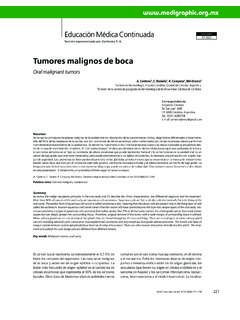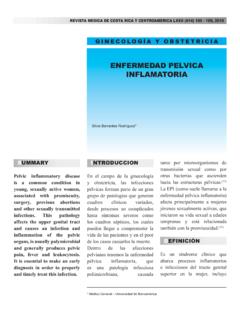Transcription of 5.6 Recommendations for preventing dental diseases
1 For preventing dental health is related to diet in many ways, for example, throughnutritional influences on cranio-facial development, oral cancer and oralinfectious diseases . The purpose of this review, however, is to focus on ,developmental defects of enamel, dental erosion and periodontal diseases are a costly burden to health care services, accounting forbetween 5% and 10% of total health care expenditures and exceeding thecost of treating cardiovascular disease, cancer and osteoporosis inindustrialized countries (1). In low-income countries, the cost oftraditional restorative treatment of dental disease would probably exceedthe available resources for health care. dental health promotion andpreventive strategies are clearly more affordable and not life-threatening, dental diseases have a detrimental effecton quality of life in childhood through to old age, having an impact onself-esteem, eating ability, nutrition and health.
2 In modern society, asignificant role of teeth is to enhance appearance; facial appearance isvery important in determining an individual s integration into society,and teeth also play an essential role in speech and communication. Oraldiseases are associated with considerable pain, anxiety and impairedsocial functioning (2, 3). dental decay may result in tooth loss, whichreduces the ability to eat a nutritious diet, the enjoyment of food, theconfidence to socialize and the quality of life (4--6). amount of dental decay is measured using the dmf/DMF index, acount of the number of teeth or surfaces in a person s mouth that aredecayed, missing or filled as a result of caries in primary dentition/permanent dentition. An additional dental status indicator is theproportion of the population who are edentulous (have no natural teeth).In most low-income countries, the prevalence rate of dental caries isrelatively low and more than 90% of caries are untreated.
3 Available data(7) show that the mean number of decayed, missing or filled permanentteeth (DMFT) at age 12 years in low-income countries is , inmiddle-income countries and in high-income countries (Table 12).Data on the level of dental caries in the permanent dentition of 12-year-olds show two distinct trends. First, a fall in the prevalence of dentalcaries in developed countries, and second an increase in the prevalence ofthe disease in some developing countries that have increased theirconsumption of sugars and have not yet been introduced to the presence105of adequate amounts of fluoride. Despite the marked overall decline indental caries over the past 30 years, the prevalence of dental cariesremains unacceptably high in many developed countries. Even incountries with low average DMFT scores, a significant proportion ofchildren have relatively high levels of dental caries. Moreover, there issome indication that the favourable trends in levels of dental caries inpermanent teeth have come to a halt (8).
4 Table 12 Trends in levels of dental caries in 12-year-olds (mean DMFT per person aged 12 years)Country or areaYearDMFTYearDMFTYearDMFTI ndustrialized Republicof the Republic of Iran , decayed, missing, filled permanent : developing countries have low decayed, missing, filled primaryteeth (dmft) values but a high prevalence of dental caries in the primarydentition. Data on 5-year-old children in Europe suggest that the trendtowards reduced prevalence of dental decay has halted (9--11). Inchildren aged 5--7 years, average dmft values of below have beenreported for Denmark, England, Finland, Italy, Netherlands andNorway (12). Higher dmft values were reported recently for Belarus( ) (13), Hungary ( ) (14), Romania ( ) (15) and the RussianFederation ( ) (16).Being free from caries at age 12 years does not imply being caries-free forlife.
5 The mean DMFT in countries of the European Union after 1988varied between and at 35--44 years (17). The WHO guidelines onoral health state that at age 35--44 years a DMFT score of 14 or above is106considered high. In most developing countries, the level of caries in adultsof this age group is lower, for example, in China (18) and in Niger(19). Few data are available on the prevalence and severity of root caries inolder adults, but with the increasingly ageing population and greaterretention of teeth, the problem of root caries is likely to become asignificant public health concern in the number ofedentulouspersonshas declined overthe past20--30 yearsin several industrialized countries (3). Despite overall gains however,there is still a large proportion of older adults who are edentulous orpartially dentate and as the population continues to age tooth loss willaffect a growing number of persons worldwide.
6 Table 13 summarizes theavailable information on the prevalence of edentulousness in old-agepopulations throughout the erosion is a relatively new dental problem in many countriesthroughout the world, and is related to diet. There is anecdotal evidencethat prevalence is increasing in industrialized countries, but there are nodata over time to indicate patterns of this disease. There are insufficientdata available to comment on worldwide trends; in some populations,however,itis thoughtthatapproximately50%ofchildrenare affected(20). and dental diseaseNutritional status affects the teeth pre-eruptively, although thisinfluence is much less important than the post-eruptive local effect ofdiet on the teeth (21). Deficiencies of vitamins D and A and protein--energy malnutrition have been associated with enamel hypoplasia andsalivary gland atrophy (which reduces the mouth s ability to bufferplaque acids), which render the teeth more susceptible to decay.
7 Indeveloping countries, in the absence of dietary sugars, undernutrition isnot associated with dental caries. Undernutrition coupled with a highintake of sugars may exacerbate the risk of is some evidence to suggest that periodontal disease progressesmore rapidly in undernourished populations (22); the important role ofnutrition in maintaining an adequate host immune response may explainthis observation. Apart from severe vitamin C deficiency, which mayresult in scurvy-related periodontitis, there is little evidence at present foran association between diet and periodontal disease. Current research isinvestigating the potential role of the antioxidant nutrients in period-ontal disease. Poor oral hygiene is the most important risk factor in thedevelopmentofperiodontal disease(21). Undernutritionexacerbates theseverity oforalinfections ( acutenecrotizingulcerative gingivitis)andmay eventually lead to their evolution into life-threatening diseases suchas noma, a dehumanizing oro-facial gangrene (23).
8 107 Table 13 Prevalence of edentulousness in older people throughout the worldCountry or areaPrevalence ofedentulousness (%)Age group(years)African RegionGambia665 +Madagascar2565--74 Region of the AmericasCanada5865 +United Sates2665--69 South-East Asian RegionIndia1965--74 Indonesia2465 +Sri Lanka3765--74 Thailand1665 +European RegionAlbania6965 +Austria1565--74 Bosnia and Herzegovina7865 +Bulgaria5365 +Denmark2765--74 Finland4165 +Hungary2765--74 Iceland1565--74 Italy1965--74 Lithuania1465--74 Poland2565--74 Romania2665--74 Slovakia4465--74 Slovenia1665 +United Kingdom4665 +Eastern Mediterranean RegionEgypt765 +Lebanon2064--75 Saudi Arabia31--4665 +Western Pacific RegionCambodia1365--74 China1165--74 Malaysia5765 +Singapore2165 +Source: caries occur because of demineralization of enamel and dentine byorganic acids formed by bacteria in dental plaque through the anaerobicmetabolism of sugars derived from the diet (24).
9 Organic acids increase thesolubility of calcium hydroxyapatite in the dental hard tissues anddemineralization occurs. Saliva is super-saturated with calcium andphosphate at pH 7 which promotes remineralization. If the oral pHremains high enough for sufficient time then complete remineralization of108enamel may occur. If the acid challenge is too great, however,demineralization dominates and the enamel becomes more porous untilfinally a carious lesion forms (25). The development of caries requires thepresence of sugars and bacteria, but is influenced by the susceptibility ofthe tooth, the bacterial profile, and the quantity and quality of the sugars and dental cariesThere is a wealth of evidence from many different types of investigation,including human studies, animal experiments and experimental studies invivo and in vitro to show the role of dietary sugars in the etiology of dentalcaries (21). Collectively, data from these studies provide an overall pictureof the cariogenic potential of carbohydrates.
10 Sugars are undoubtedly themost important dietary factor in the development of dental caries. Here,the term sugars refers to all monosaccharides and disaccharides, whilethe term sugar refers only to sucrose. The term free sugars refers to allmonosaccharides and disaccharides added to foods by the manufacturer,cook or consumer, plus sugars naturally present in honey, fruit juices andsyrups. The term fermentable carbohydrate refers to free sugars,glucose polymers, oligosaccharides and highly refined starches; it excludesnon-starch polysaccharides and raw epidemiological studies have compared sugar consumptionand levels of dental caries at the between-country level. Sreebny (26, 27)correlated the dental caries experience (DMFT) of 12-year-olds withdata on sugar supplies of 47 countries and found a significant correlation(+ ); 52% of the variation in the level of caries was explained by theper capita availability of sugar.
















